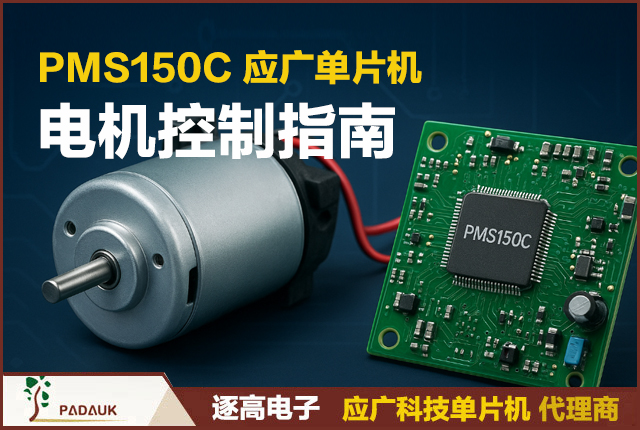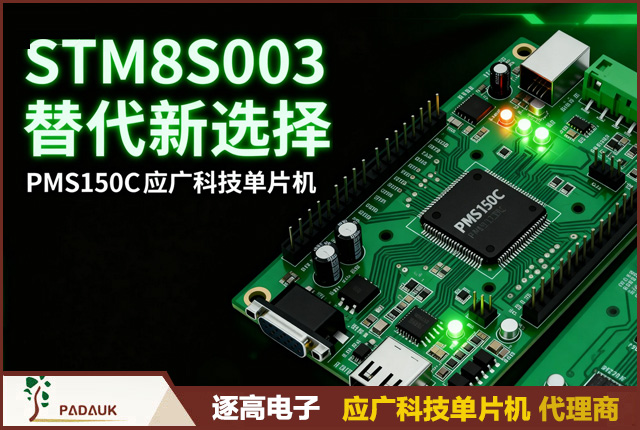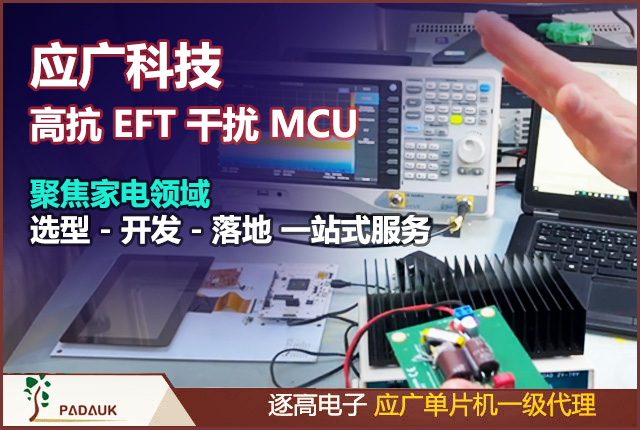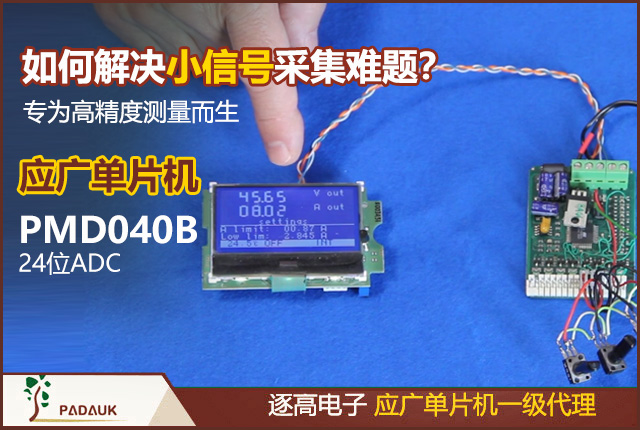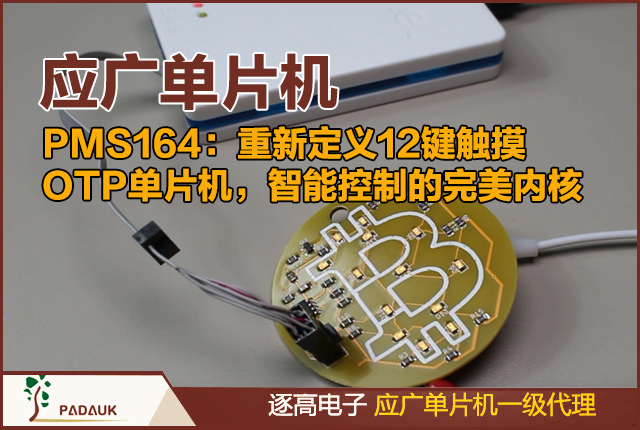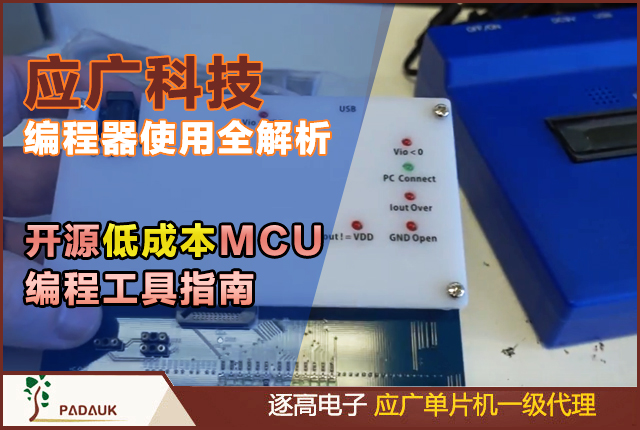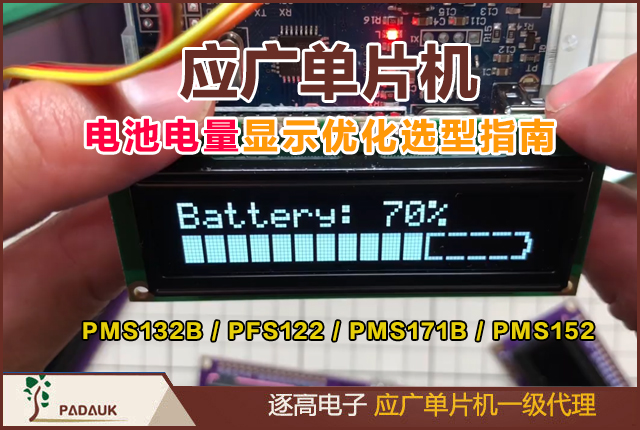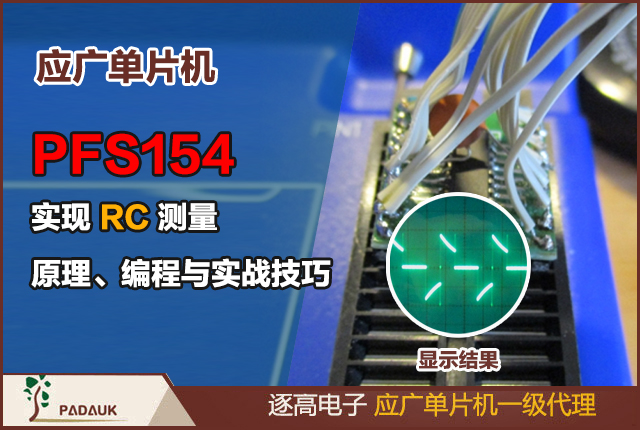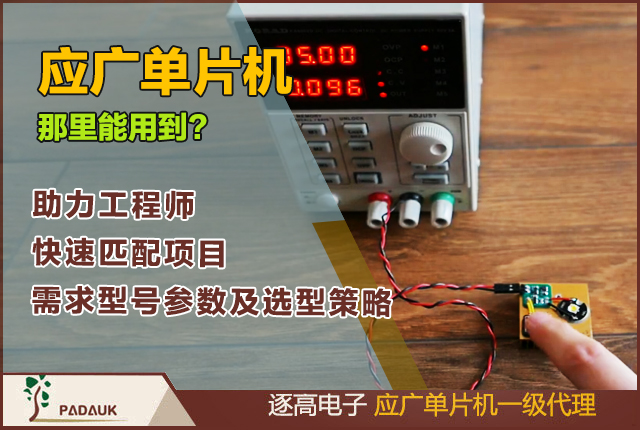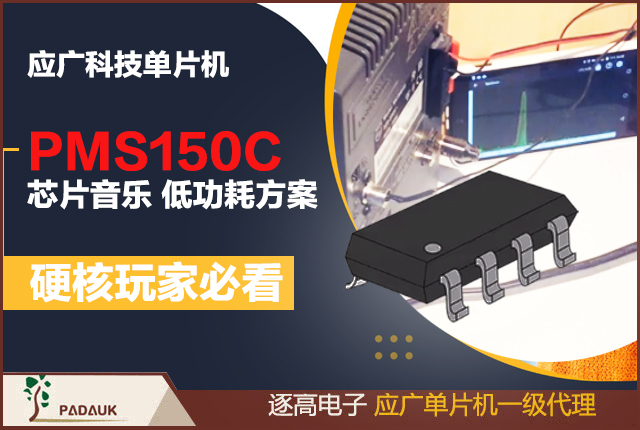八核心单片机有什么优点
FPPA 架构介绍
FPPA 产品特色
内建硬体的即时作业系统
FPPA 暂存器说明
FPPA 软体规划
FPPA 指令介绍

八核心平行处理单片机 (FPPA) 介绍
八核心单片机有什么优点:
相信许多研发人员都有选择 MCU 的痛苦经验, 选这颗 MCU 少个 UART,选那颗 Timer 又不够,就算选好了 MCU,写多功 (Muti-Task)的软体才是真正痛苦的开始.
应广科技(Padauk )八核心平行处理单片机Field Programmable Processor Array, 以下简称“FPPA”,利用八核心平行处理可一次解决软体“Muti-Task” ,“Timer” 和MCU 所需的各种周边的困扰.有八颗MCU 平行处理,不用再烦恼多工软体,有八颗MCU 平行处理等于有八个Timer,不用再烦恼Timer 不够,有八颗MCU 平行处理,拿几颗来写UART,I2C,SPI ,PWM 等周边就不用再烦恼介面不够.
FPPA 架构介绍
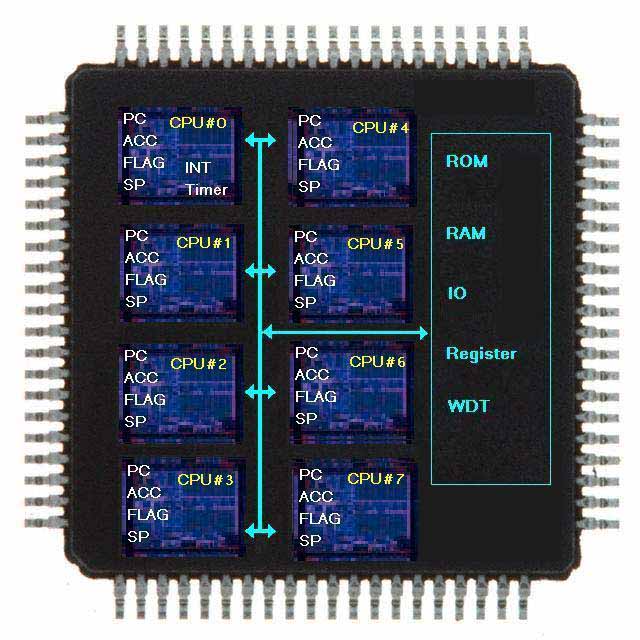
如上图所示
基本上应广科技(Padauk )的FPPA, inside 了8 颗RISC type 1T 的MCU, 除了每颗MCU 有自己的Flag ,PC counter, Stack pointer, Accumulator 外,其余的ROM,RAM,IO 等是共用的.故每一MCU 都可随时监控其他MCU 的状况.(MCU#0 还多了16bit 的timer & 中断管理可处理I/O中断和内部中断).
8 颗MCU 是平行处理,且每个I/O 都可设为input 或output 或pull-hi 或open-drain,故可用软体去控制I/O写各种周边介面, 如I2C, UART,PWM,SPI等非常有弹性(如MCU#0 写UART, MCU#1写I2C, MCU#2 写PWM 等,几乎没有限制.) 软体去作SOC 周边功能,故成本很有竞争力,和弹性,不会受限一般MCU 原厂所开的IC 规格.
除了 一般 MCU 的指令外, 还有 类似 FPGA 才有 I/O 指令,对 I/O 的处理特别精简和有效率.可取代部分的 PAL/GAL/FPAG 等逻辑合成电路.
产品特色 Features
内建 8 颗 RISC type 平行处理,多核心 CPU 矩阵 (Field Programmable Processor Array“FPPA”).
内建硬体的即时作业系统 (hardware RTOS).
97 个 1T RISC type 功能强大的指令. (不同系列,指令略有增减)
支援 C/Assembly language/Macro 程式语言.
可自由规划每一 MCU 的堆叠(stack pointer) 深度.
支援12bitx8ch ADC.
弹性方便的位元操作指令 (Bit-manipulation).
全部的资料记忆体都可用指标定址 (index pointer addressing).
可自由规划每一 MCU 的程式空间 ( OTP program memory).
每一 I/O 都可弹性定义为 input 或 output或 pull-hi或 open-drain.
内建高速/慢速 RC振荡器.
独家的 intra-FPP handshaking指令,每一 MCU 可控制其他 MCU 的程式指标 (program counter).
独家的内部中断,MCU#1 – MCU7 可发出中断需求,让 MCU#0当中断优先处理.
独家的 “wait0”, “wait1” 指令,对 IO 的处理特别精简和有效率.
独家的 “delay x” (x 0 – 255)指令,可直接 delay x 的 system clock.
内建硬体的即时作业系统 (hardware RTOS)
FPPA 最多可有8 颗MCU 同时平行处理, FPPA 有一“pmode”指令可调整每一MCU 的速度,FPPA 根据“pmode”由硬体强制去分配的每一MCU 的bandwidth 来完成类似软体RTOS 的功能(如下表),完全不用写软体的RTOS.
| pmode | FPP0 | FPP1 | FPP2 | FPP3 | FPP4 | FPP5 | FPP6 | FPP7 |
| 0 | 1/2 | 1/8 | 1/16 | 1/16 | 1/16 | 1/16 | 1/16 | 1/16 |
| 1 | 1/4 | 1/4 | 1/8 | 1/8 | 1/16 | 1/16 | 1/16 | 1/16 |
| 2 | 1/8 | 1/8 | 1/8 | 1/8 | 1/8 | 1/8 | 1/8 | 1/8 |
| 3 | 1/2 | 1/8 | 1/8 | 1/8 | ||||
| 4 | 1/4 | 1/4 | 1/4 | 1/8 | 1/8 | |||
| 5 | 1/16 | 1/4 | 1/4 | 1/4 | 1/16 | 1/16 | 1/16 | |
| 6 | 1/16 | 1/2 | 1/8 | 1/16 | 1/16 | 1/16 | 1/16 | 1/16 |
| 7 | 1/8 | 1/2 | 1/8 | 1/8 | 1/8 |
如下图为 pmode =2 , 平均每一 MCU 分配 1/8 system clock
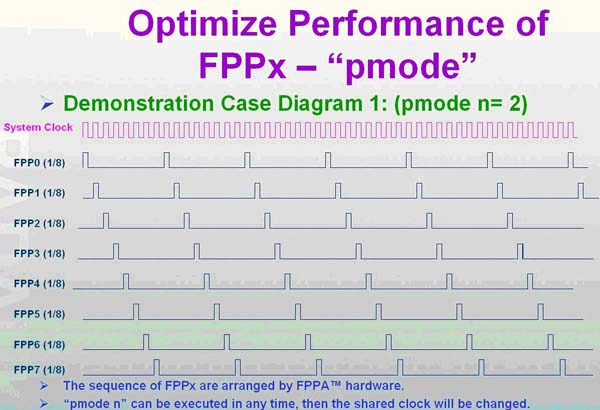
下图为 pmode=0 ,FPP#0 = 1/2 system clock, FPP#1 = 1/4 system clock, FPP#2-FPP#7 = 1/16 system clock ,每个 FPP 的 cycle 如下
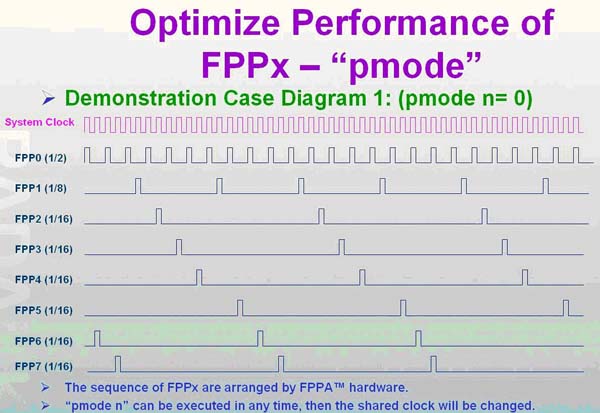
FPPA暂存器 (Registers) 说明
| Name | Address | Function |
| flag | 0x00 | Arithmetic status flag |
| fppen | 0x01 | FPP unit enable register |
| sp | 0x02 | Stack pointer |
| clkmd | 0x03 | Clock mode register |
| inten | 0x04 | Interrupt enable register |
| intrq | 0x05 | Interrupt request register |
| t16m | 0x06 | Timer 16 mode register |
| gdio | 0x07 | General data register for IO |
| mulop | 0x08 | One operand for multiplication |
| mulrh | 0x09 | High byte result of multiplication (read only) |
| eoscr | 0x0a | External oscillator setting register |
| ihrcrl | 0x0b | Internal high RC oscillator control register low |
| Ihrcrh | 0x0c | Internal high RC oscillator control register high |
| pa | 0x10 | Port A data register |
| pac | 0x11 | Port A control register |
| paph | 0x12 | Port A pull high register |
| paod | 0x13 | Port A open drain register |
| pb | 0x14 | Port B data register |
| pbc | 0x15 | Port B control register |
| pbph | 0x16 | Port B pull high register |
| pbod | 0x17 | Port B open drain register |
| pc | 0x18 | Port C data register |
| pcc | 0x19 | Port C control register |
| pcph | 0x1a | Port C pull high register |
| pcod | 0x1b | Port C open drain register |
| pd | 0x1c | Port D data register |
| pdc | 0x1d | Port D control register |
| pdph | 0x1e | Port D pull high register |
| pdod | 0x1f | Port D open drain register |
| pe | 0x30 | Port E data register |
| pec | 0x31 | Port E control register |
| peph | 0x32 | Port E pull high register |
| peod | 0x33 | Port E open drain register |
PPA 共有33 个暂存器(不同系列暂存器略有不同),其中address 0x10 – 0x32 各为I/O Port A – Port E 的控制暂存器,故真正要注意的register 只有13 个,不像其他MCU,周边控制(如PWM,I2C,UART 等)的register 就好几拾个,故FPPA 很容易学习U. 13个register 中比较容易引起误解,或datasheet 描述不易理解的地方特别提出说明.
“sp” & “flag”: 由于 FPPA 有8颗 MCU,故每一 MCU 看到的 “sp” & “flag” 的值是不一样的值.
“fppen”: 由于 FPPA 有8颗 MCU,但并不是每个应用 8 颗 MCU 都要去 enable, 故可用 “fppen” register 去控制那些 MCU 需要 enable.
gdio”: register “gdio” 可以做下列二种应用
当warm-boot 或cool-boot的判断用:由于FPPA 开机或reset 时, “gdio” 的值不会去变更,故程式执行中可故意写入一个值给“gdio”,而在程式开始的地方去判断“gdio” 的值是否为程式执行中所写入的值即可判断MCU 是否是第一次开机或是reset 再开机.
让MCU & MCU 间的沟通更有效率:“wait0” 和“ wait1” 指令除了可对I/O 处理外, 也可对“gdio” 暂存器处理, (Ex.: “wait0 gdio.x”) , 例如在MCU#1 中把“gdio.x” 设为0 或1, MCU#2 用“wait0” 或“wait1”指令去做条件的判断亦可达到MCU#1 和MCU#2 之间的沟通.
FPPA 软体规划
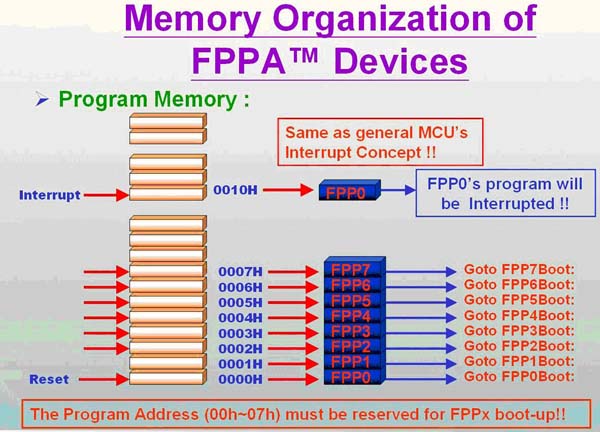
如上图所示,和大多数的MCU 一样,FPPA 也有所谓“中断向量表”的概念,只是一般MCU 的中断向量是“中断副程式” 的进入位置,FPPA 的中断向量是各FPP 的进入位置.如上图中address 0h-7h 分别为FPP#0-7 的进入位置,address 0x10 才是“中断副程式” 的进入位置,故其程式写法如下
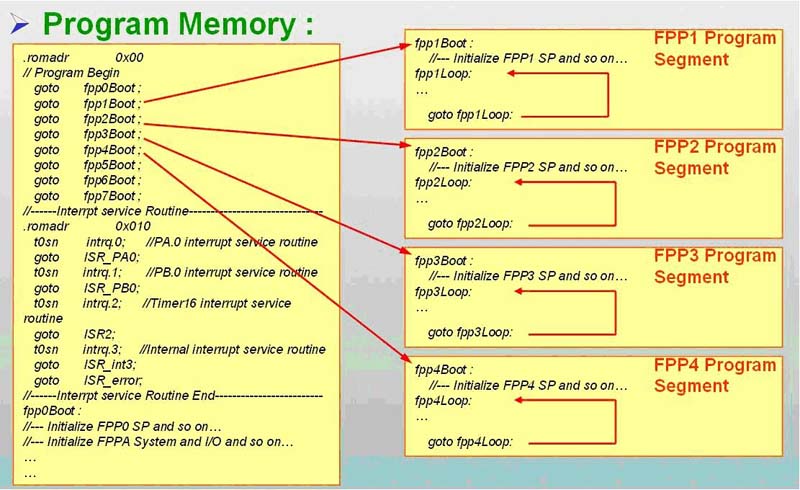
FPPA 指令介绍 (Instructions Set)
| FPPA Instructions Set | |
| Data Transfer Instructions (16) | |
| Instruction | Function |
| mov a,I | Move immediate data to ACC。 |
| mov M,a | Move data from ACC to memory |
| mov a,M | Move data from memory to ACC |
| mov a,IO | Move data from IO to ACC |
| mov IO,a | Move data from ACC to IO |
| pushw index | Move the content of index to be the content of stack pointer |
| pushw pcN | Move the content of program counter of Nth FPP unit to be the content of stack pointer |
| popw index | Restore the content of stack pointer to be the content of index |
| popw pcN | Restore the content of stack pointer to be the content of program counter of the Nth FPP unit |
| ldtabh index | Load high byte data in OPT to ACC by using index as OPT address |
| ldtabl index | Load low byte data in OTP to ACC by using index as OTP address |
| ldt16 index | Move 16-bit counting values in Timer16 to memory which is addressed by index |
| stt16 index | Store 16-bit data from memory addressed by index to Timer16 |
| idxm a,index | Move data from specified memory to ACC by indirect method |
| idxm index,a | Move data ACC to specified memory by indirect method |
| xch M | Exchange data between ACC and memory |
| Arithmetic Operation Instructin (20) | |
| add a,I | Add immediate data with ACC, then put result in ACC |
| add a,M | Add data in memory with ACC, then put result in ACC |
| add M,a | Add data in memory with ACC, then put result in ACC |
| addc a,M | Add data in memory with ACC and carry bit, then put result in ACC |
| addc M,a | Add data in memory with ACC and carry bit, then put result in memory |
| addc a | Add carry with ACC, then put result in ACC |
| addc M | Add carry with memory, then put result in memory |
| nadd a,M | Add negative logic (2's complement) of ACC with memory |
| nadd M,a | Add negative logic (2's complement) of memory with ACC |
| sub A,I | Subtraction immediate data from ACC, then put result in ACC. |
| sub a,M | Subtraction data in memory from ACC, then put result in ACC. |
| sub M,a | Subtraction data in ACC from memory, then put result in memory |
| subc a,M | Subtraction data in memory and carry from ACC, then put result in ACC |
| subc M,a | Subtraction ACC and carry bit from memory, then put result in memory |
| subc a | Subtraction carry from ACC, then put result in ACC |
| subc M | Subtraction carry from the content of memory, then put result in memory |
| inc M | increment the content of memory |
| dec M | Decrement the content of memory |
| clear M | Clear the content of memory |
| mul | Multiplication operation. An 8x8 unsigned multiplication will be executed. |
| Shift Operation Instructions (11) | |
| sr a | Shift right of ACC |
| src a | Shift right of ACC with carry |
| sr M | Shift right the content of memory |
| src M | Shift right of memory with carry |
| sl a | Shift left of ACC |
| slc a | shift left of ACC with carry |
| sl M | Shift left of memory |
| slc M | Shift left of memory with carry |
| swap a | Swap the high nibble and low nibble of ACC |
| swap M | Swap th high nibble and low nibble of memory |
| Logic Operation Instructions (16) | |
| and a,I | Per logic AND on ACC and immediate data, then put result in ACC |
| and A,M | Per logic AND on ACC and memory, then put result in ACC |
| and M,a | Per logic AND on ACC and memory, then put result in memory |
| or a,I | Per logic OR on ACC and immediate data, then put result in ACC |
| or a,M | Per logic OR on ACC and memory, then put result in ACC |
| or M,a | Per logic OR on ACC and memory, then put result in memory |
| xor a,I | Per logic XOR on ACC and immediate data, then put result in ACC |
| xor a,M | Per logic XOR on ACC and memory, then put result in ACC |
| xor M,a | Per logic XOR on ACC and memory, then put result in memory |
| not a | Per 1's complement (logical complement) of ACC |
| not Mry | Per 1's complement (logical complement) of memo |
| neg a | Per 2's complement of ACC |
| neg M | Per 2's complement of memory |
| comp a,I | Compare ACC with immediate data |
| comp a,M | Compare ACC with the content of memory |
| comp M,a | Compare ACC with the content of memory |
| Operation Instructions (6) | |
| set0 IO.n | Set bit n of IO port to low |
| set1 IO.n | Set bit n of IO port to high |
| tog IO.n | Toggle bit state of bit n of IO port |
| set0 M.n | Set bit n of memory to low |
| set1 M.n | Set bit n of memory to high |
| swapc IO.n | Swap the n-th bit of IO port with carry bit |
| Conditonal Operation Instructions (13) | |
| ceqsn a,I | Compare ACC with immediate data and skip next instruction if both are equal |
| ceqsn a,M | Compare ACC with memory and skip next instruction if both are equal |
| cesn M,a | Compare ACC with memory and skip next instruction if both are equal |
| t0sn IO.n | Check IO bit and skip next instruction if it's low |
| t1sn IO.n | Check IO bit and skip next instruction if it's high |
| t0sn M,n | Check memory bit and skip next instruction if it's low |
| t1sn M,n | Check memory bit and skip next instruction if it's high |
| izsn a | increment ACC and skip next instruction if ACC is zero |
| dzsn a | Decrement ACC and skip next instruction if ACC is zero |
| izsn M | Increment memory and skip next instruction if memory is zero |
| dzsn M | Decrement memory and skip next instruction if memory is zero |
| wait0 IO.n | Go next instruction until bit n of IO power is low; otherwise, wait here |
| wait1 IO.n | Go next instruction until bit n of IO power is high; otherwise, wait here |
FPPA 共有97 个(不同系列,指令略有增减)1T RISC type 功能强大的指令.大部分的指令看datasheet 就知道其用法,不再多叙,这里只介绍比较容易引起误解,或datasheet 叙述不容易理解的地方特别提出说明
wait0,wait1: 只能针对I/O 或register “gdio”,但不能对记忆体, 其功能如流程图所示,一直要等到I/O 或gdio.x =0 或1 成立才往下继续执行,因传统的MCU,只有一颗MCU,故无法去实现这种指令,否则如果条件不成立,程式就一直停在那,形同“当机”.
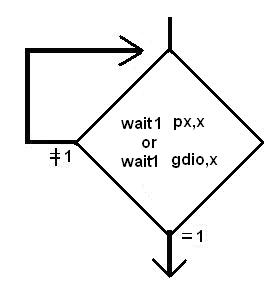
delay :直接delay x 个system clock 才往下继续执行, 例如system clock = 8Mhz,pmode = 0,FPP#0 执行“delay 100” =100*1/4M = 25us,但FPPA#1执行“delay 100” = 100 * 1/1M = 100us.
pushw,popw: push & pop 程式指标
由于PFPA 是一颗8 核心的MCU,不同MCU 间可更改彼此的程式指标“pc”, 来达到强迫其他MCU 去执行某段程式的路径之目的,但要小心运用,否则容易破坏程式的结构.下例中的FPP#0 原本只会在LOOP_A无穷的回圈中打转, FPP#1 经由“pushw” 和“popw” 改变了FPP#0 的程式指标, 让FPP#0 变在LOOP_B无穷回圈中打转.
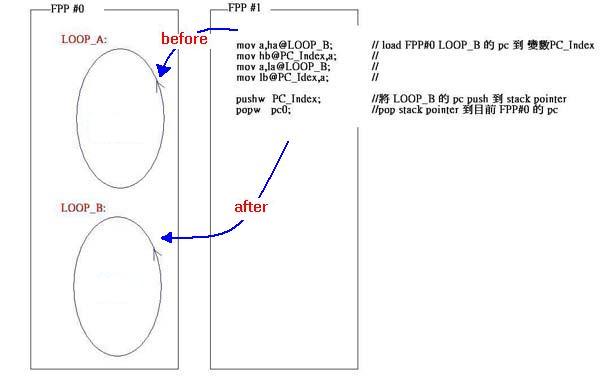
逐高电子技术部整理

